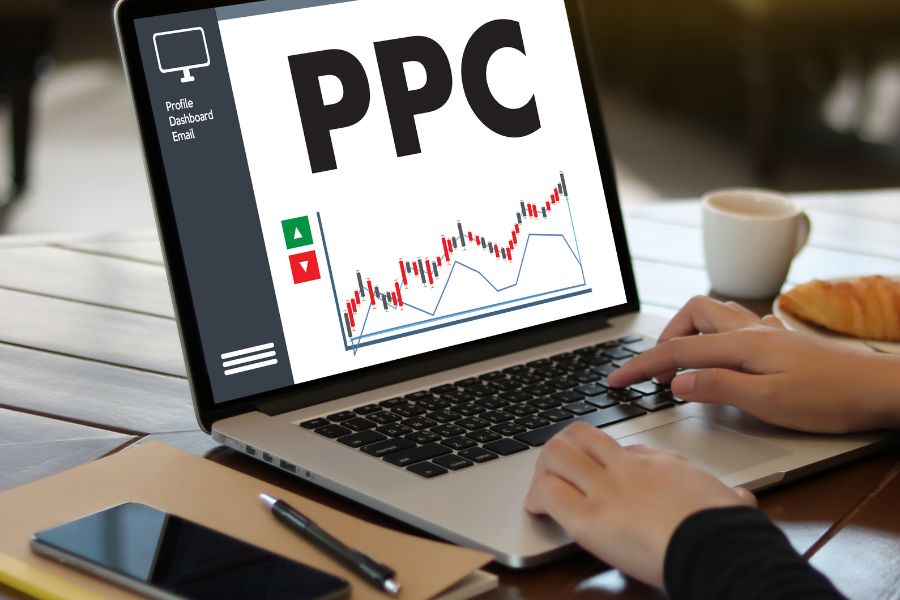We don't like gatekeeping information
A collection of business & marketing articles – a gift from us to you

- March 27, 2024
- E-Shops / ECommerce
In today’s digital world, e-commerce reigns supreme. Consumers are increasingly turning to online stores for convenience, wider selection, and competitive pricing. If you own an e-commerce business, your website is your virtual storefront – the key to attracting customers and driving sales. But simply having an online store isn’t enough. To thrive in the competitive e-commerce landscape, you need a website that converts visitors into loyal buyers.
Here are some key steps to take your e-commerce store from browsing hub to conversion champion:
1. User-Friendly Navigation:
First impressions matter. Your website’s navigation should be intuitive and user-friendly. Visitors should be able to easily find the products they’re looking for with clear categories, subcategories, and a search bar that functions flawlessly. A smooth navigation experience keeps visitors engaged and eliminates frustration.
2. High-Quality Product Images and Descriptions:
Compelling product images are essential for online shopping. Showcase your products with high-resolution photos that capture details from multiple angles. Pair these visuals with informative and engaging product descriptions. Highlight key features, benefits, and specifications, and consider incorporating user-generated content like customer reviews for added trust.
3. Trust and Security Signals:
Online shoppers are wary of sharing their personal information. Build trust and establish your website’s credibility by displaying prominent security badges and certificates. Clearly outline your return policy, shipping information, and customer service contact details.
4. Streamlined Checkout Process:
A complex checkout process is a conversion killer. Strive for a streamlined checkout that is quick and easy to navigate. Offer multiple payment options, including popular credit cards and digital wallets, to cater to different customer preferences. Minimize the number of steps required to complete a purchase and avoid hidden fees at checkout.
5. Mobile Optimization:
The majority of online shopping happens on mobile devices. Ensure your e-commerce website is fully responsive and optimized for mobile browsing. Text should be readable, buttons should be easy to tap, and product pages should load quickly on all devices.
6. Embrace the Power of CTAs:
Clear calls to action (CTAs) guide visitors and tell them what you want them to do next. Use strong CTAs like “Add to Cart,” “Buy Now,” or “Learn More,” placed strategically throughout your website. Make your CTAs stand out visually and encourage visitors to take the desired action.
7. Leverage Customer Reviews and Social Proof:
Positive customer reviews and social proof build trust and encourage hesitant buyers to take the plunge. Display customer testimonials, showcase product ratings, and integrate social media feeds to demonstrate customer engagement and brand loyalty.
8. Retargeting and Remarketing:
Not every visitor converts on the first visit. Retargeting and remarketing campaigns reconnect with visitors who have shown interest in your products but haven’t completed a purchase. This reminds them of your brand and entices them to come back and complete their purchase.
9. Offer Promotions and Discounts:
Strategic promotions and discounts can incentivize purchases and drive conversions. Offer limited-time discounts, free shipping for orders above a certain amount, or bundle deals to entice customers.
10. Track and Analyze:
Data is your friend in e-commerce. Utilize website analytics tools to track user behavior, identify areas for improvement, and measure the effectiveness of your conversion optimization efforts. By analyzing data, you can continuously refine your website and marketing strategies to maximize conversions.
By implementing these steps and staying up-to-date with e-commerce best practices, you can transform your website from a digital brochure into a conversion powerhouse. Remember, a successful e-commerce store prioritizes customer experience, builds trust, and makes the buying process seamless and enjoyable. By focusing on these key elements, you can turn casual browsers into loyal customers who keep your online store thriving.

- March 27, 2024
- Marketing
In today’s digital age, where inboxes overflow with messages, email marketing might seem like a relic of the past. However, email remains one of the most effective and cost-efficient marketing channels available. This article will explore the power of email marketing, its importance in your marketing strategy, and how you can leverage it to connect with your audience and achieve your business goals.
What is Email Marketing?
Email marketing is the practice of using email to communicate with your target audience. It involves sending targeted messages promoting your products or services, sharing valuable content, nurturing leads, and building customer relationships.
Why is Email Marketing Important?
Compared to other marketing channels, email marketing boasts several advantages:
- High ROI: Email marketing offers a significant return on investment (ROI). The low cost of sending emails combined with the potential for high conversion rates makes it an attractive option for businesses of all sizes.
- Direct Communication: Email allows you to send personalized messages directly to your audience’s inbox. This fosters a more personal connection and increases engagement compared to impersonal social media posts.
- Measurable Results: Unlike traditional marketing methods, email marketing provides valuable data and insights. You can track open rates, click-through rates, and conversions, allowing you to measure the effectiveness of your campaigns and optimize them for better results.
- Relationship Building: Email marketing goes beyond just promoting products. It allows you to nurture relationships with your audience by providing valuable content, building trust, and establishing yourself as an authority in your field.
Leveraging the Power of Email Marketing:
Here are some ways to leverage email marketing for your business:
- Build Your Email List: Offer valuable incentives like discounts or exclusive content in exchange for email addresses. Focus on building a permission-based list filled with engaged subscribers.
- Segment Your Audience: Personalize your emails by segmenting your list based on demographics, interests, or purchase history. This ensures your messages are relevant and resonate with each recipient.
- Craft Engaging Content: Don’t just bombard your subscribers with promotional emails. Offer valuable content like blog posts, industry news, or helpful tips to build trust and keep them engaged.
- Optimize Your Calls to Action (CTAs): Tell your subscribers exactly what you want them to do next. Use clear and compelling CTAs that encourage them to visit your website, make a purchase, or learn more about your offerings.
- Track and Analyze: Monitor your email campaign performance and analyze data like open rates, click-through rates, and conversions. Use this data to identify what’s working and adjust your strategy for better results.
Getting Started with Email Marketing:
Starting with email marketing is easier than you might think:
- Choose an Email Marketing Service Provider (ESP): Several ESPs offer user-friendly platforms with features like email list management, campaign creation, and analytics.
- Develop Your Email Strategy: Define your goals and target audience. What do you want to achieve with email marketing? Who are you trying to reach?
- Create Engaging Content: Focus on providing value and tailoring content to your audience’s interests.
- Start Building Your List: Offer incentives to encourage signups and focus on building a permission-based list.
Email marketing remains a powerful tool in today’s marketing landscape. By understanding its benefits, leveraging its strengths, and implementing a strategic approach, you can use email marketing to connect with your audience, nurture leads, and ultimately achieve your business goals. Remember, consistent effort and a commitment to providing value are key to building successful email marketing campaigns.

- March 27, 2024
- Marketing
In the ever-evolving world of online advertising, two platforms reign supreme: Google Ads and Meta Ads (formerly Facebook Ads). Both offer powerful tools to reach your target audience and achieve your marketing goals, but they excel in different areas. Understanding these differences is crucial for maximizing the effectiveness of your advertising campaigns.
Targeting Powerhouses:
- Google Ads: Leverages user search intent. Your ads appear alongside search results when users enter specific keywords related to your product or service. This allows you to target users who are actively searching for solutions, making them highly qualified leads.
- Meta Ads: Focuses on user demographics and interests. You can target users based on a vast array of criteria, including demographics, interests, behaviors, and online activity. This allows you to reach a broader audience who might not be actively searching but may be receptive to your message.
Content and Creativity:
- Google Ads: Primarily text-based ads with limited space for visuals. Focus on crafting clear, concise, and keyword-rich ad copy that compels users to click.
- Meta Ads: Offers a wider range of ad formats, including images, videos, and carousels. This allows for more creative storytelling and brand awareness building.
Campaign Goals:
- Google Ads: Often excels at driving conversions and immediate sales. Since users are actively searching, they’re more likely to be in the decision-making stage of the buying journey.
- Meta Ads: Effective for brand awareness, lead generation, and audience building. The platform allows you to nurture relationships with potential customers and build brand loyalty over time.
The Power of “Both”:
While Google Ads and Meta Ads have distinct strengths, they can be a powerful combination when used strategically. Running campaigns on both platforms allows you to:
- Reach a Wider Audience: Expand your reach beyond users actively searching on Google by capturing those browsing social media platforms.
- Nurture Leads Throughout the Funnel: Use Google Ads to target users with purchase intent and Meta Ads to engage and educate potential customers at earlier stages.
- Gain Valuable Data: Insights from both platforms can provide a holistic view of your audience and campaign effectiveness, allowing for further optimization.
The Choice is Yours:
Ultimately, the best platform for you depends on your specific marketing goals, target audience, and budget. Consider your needs:
- Are you looking for immediate conversions or long-term brand awareness?
- Do you have a clearly defined target audience with specific search terms?
- What kind of content best represents your brand and resonates with your audience?
By carefully evaluating your goals and target audience, you can determine whether Google Ads, Meta Ads, or a strategic combination of both is the right weapon for your digital advertising arsenal. Remember, a successful online advertising strategy requires flexibility and ongoing optimization. Test different approaches, analyze results, and refine your campaigns to maximize your return on investment (ROI).

- March 27, 2024
- Marketing
In today’s digital marketing landscape, paid advertising is a powerful tool for driving targeted traffic to your website. You invest time and resources crafting compelling ads to reach your ideal customer. But where do you send that valuable click? While it might seem convenient to direct them to your homepage, a dedicated landing page specifically designed for your ad campaign offers significant advantages.
Laser Focus, Maximum Impact:
Unlike your website’s homepage, which serves a variety of purposes, a landing page has one singular goal: to convert visitors who clicked on your ad. This laser focus allows you to tailor the entire page experience to align perfectly with your ad’s message and offer.
Clear Call to Action:
Landing pages eliminate distractions. There are no competing navigation menus or links to other parts of your website. Instead, the landing page prominently features a clear and compelling call to action (CTA) that directly relates to your ad. Whether it’s “Download the Free Ebook,” “Sign Up for the Free Trial,” or “Buy Now,” the CTA tells visitors exactly what you want them to do next.
Enhanced Relevance:
Landing pages allow you to create a highly relevant experience for visitors arriving from your ad. The content, visuals, and messaging on the landing page should directly mirror the content of your ad. This reinforces the user’s initial impression and increases the likelihood of them converting.
Improved Conversion Rates:
By removing distractions and focusing solely on a specific conversion goal, landing pages typically boast significantly higher conversion rates compared to generic website pages. This translates to a better return on your investment (ROI) for your paid advertising campaigns.
Measurable Results:
Landing pages allow you to track user behavior and measure the success of your ad campaigns with greater precision. Since visitors arriving at your landing page came from a specific ad, you can analyze their actions and optimize your campaigns for better performance.
A Seamless User Journey:
A well-designed landing page creates a smooth and seamless user journey for visitors who clicked on your ad. From the moment they arrive, they’re greeted with a message and visuals that are consistent with the ad that piqued their interest. This continuity fosters trust and encourages them to take the desired action.
By incorporating dedicated landing pages into your paid advertising strategy, you can significantly improve your campaign results. Landing pages ensure your paid clicks translate into real conversions, ultimately maximizing the effectiveness of your marketing efforts and driving business growth.

- March 27, 2024
- Web Design / Development
Your website’s homepage is like the storefront window of your physical store – it’s the first impression potential customers will have of your brand. In a matter of seconds, visitors decide whether to stay and explore or click away. This is why crafting a compelling and informative homepage is crucial.
To capture attention and effectively communicate your brand’s value proposition, your homepage should incorporate specific sections designed to engage, inform, and convert visitors. Let’s explore the 6 essential sections you should include:
1. Hero Section:
This is the prime real estate at the top of your homepage, often featuring a large banner or image. The hero section should be visually captivating and immediately grab the visitor’s attention. Here are some tips:
- Compelling Visual: Use a high-quality image or video that effectively represents your brand and resonates with your target audience.
- Clear Headline: Craft a concise and impactful headline that communicates your value proposition and entices visitors to learn more.
- Call to Action (CTA): Tell visitors what you want them to do next, whether it’s browsing products, subscribing to a newsletter, or contacting you. Use a clear and contrasting CTA button.
2. About Us:
The “About Us” section allows you to introduce your brand, its story, and the team behind it. This builds trust and fosters a connection with your visitors.
- Brand Story: Briefly share your company’s history, mission, and values. What makes you unique?
- Team Introduction: Highlight the expertise and experience of your team members, showcasing your competence.
3. Value Proposition:
Clearly explain what you offer and how it benefits your target audience. Focus on the problems you solve and the value you deliver.
- Benefits-Oriented Content: Don’t just list features; explain how your product or service improves your customers’ lives.
- Testimonials or Case Studies: Showcase positive testimonials from satisfied customers or highlight successful case studies to build trust.
4. Services or Products:
This section showcases your offerings. Make it easy for visitors to find what they’re looking for.
- Clear Categories: Organize your products or services into well-defined categories with easy navigation.
- Compelling Descriptions: Provide concise and informative descriptions that highlight the key features and benefits of each product or service.
5. Call to Action:
Reiterate your CTAs throughout your homepage, but tailor them to specific sections.
- Multiple CTAs: Use different calls to action depending on the desired visitor action (e.g., “Learn More,” “Shop Now,” “Contact Us”).
- Strategic Placement: Place CTAs prominently throughout the homepage, but avoid being overwhelming.
6. Social Proof:
Social proof builds trust and encourages visitors to take action.
- Social Media Integration: Integrate social media icons or feeds to showcase your online presence and user engagement.
- Customer Reviews: Display positive customer reviews or ratings to demonstrate your credibility and customer satisfaction.
By incorporating these essential sections and following these tips, you can create a compelling and informative homepage that effectively captures attention, communicates your brand’s value, and converts visitors into leads or customers. Remember, your homepage is a dynamic space – regularly update content and CTAs to keep visitors engaged and ensure your website remains a valuable asset for your business.

- March 26, 2024
- Web Design / Development
In today’s digital age, a well-designed website is no longer a luxury for businesses – it’s a necessity. Your website acts as your digital storefront, a 24/7 salesperson silently working to attract, engage, and convert potential customers. But what exactly makes a website “well-designed,” and why should you invest in creating one?
Building Trust and Credibility:
A professional and well-designed website instantly establishes trust and credibility for your business. Imagine walking into a physical store with messy displays and outdated decor. A website with broken links, slow loading times, and an unintuitive layout creates a similar negative impression. A well-designed website, on the other hand, conveys professionalism and care, giving visitors confidence in your brand.
Creating a Positive First Impression:
Your website is often the first point of contact for potential customers. First impressions matter, and a well-designed website makes a positive one. High-quality visuals, clear navigation, and engaging content all contribute to a user-friendly experience that keeps visitors engaged and wanting to learn more.
Boosting Brand Awareness and Visibility:
An optimized website with strong SEO practices increases your chances of appearing at the top of search engine results pages (SERPs) for relevant keywords. This translates to significantly more organic traffic, boosting brand awareness and attracting potential customers who are actively searching for products or services like yours.
Providing a 24/7 Sales Channel:
Your website never sleeps. It functions as a tireless salesperson, showcasing your products and services around the clock, regardless of location or time zone. Customers can browse your offerings, learn about your brand, and even make purchases directly through your website, creating a seamless buying experience.
Improving Customer Engagement and Communication:
A well-designed website can foster stronger customer relationships. By incorporating features like blog posts, social media integration, and clear contact information, you create a platform for two-way communication. This allows you to share valuable content, educate your audience, and address any questions or concerns they might have.
Establishing Authority and Expertise:
Content is king in the digital world. A website allows you to showcase your expertise and establish yourself as a thought leader in your industry. Publish informative blog posts, insightful articles, or case studies that demonstrate your knowledge and value proposition. This positions you as a trusted resource, attracting potential customers seeking solutions to their problems.
Investing in a well-designed website is an investment in the future of your business. It’s a powerful tool that can help you achieve your marketing goals, generate leads, and ultimately drive sales. In a world where customers increasingly turn to the internet to find what they need, a well-designed website is no longer optional – it’s essential for success.tunesharemore_vert

- March 26, 2024
- SEO
Ever wondered why some websites appear at the top of search engine results pages (SERPs) while others languish in obscurity? The answer lies in Search Engine Optimization (SEO). In simpler terms, SEO is the practice of improving your website’s visibility in search engine results for relevant keywords.
Why is SEO important? Because in today’s digital world, where people rely on search engines to find information and products, good SEO can significantly increase your website traffic. More traffic translates to more potential customers, leads, or readers, depending on your website’s goals.
Here are 5 essential SEO steps you can take to improve your website’s ranking and searchability:
1. Keyword Research:
Think of keywords as the search terms people use to find information online. Effective SEO starts with identifying relevant keywords that your target audience is likely to search for. There are many free and paid keyword research tools available online. Once you have a list of relevant keywords, strategically integrate them throughout your website content, but be mindful not to overuse them (keyword stuffing).
2. On-Page Optimization:
On-page optimization refers to optimizing the individual pages of your website to improve their ranking for specific keywords. Here are some key on-page elements to focus on:
- Page Titles and Meta Descriptions: Craft clear, concise, and keyword-rich page titles and meta descriptions. These snippets are what users see in search results, so make them enticing and informative.
- Headings and Subheadings: Structure your content using relevant headings (H1, H2, etc.) that incorporate your keywords. This improves readability and helps search engines understand your content’s hierarchy.
- Content Quality: Create high-quality, informative, and engaging content that caters to your target audience’s needs. Focus on providing value and establishing yourself as an authority in your field.
- Image Optimization: Include relevant images and optimize them with descriptive alt text containing your target keywords. This improves accessibility and helps search engines understand the image content.
3. Mobile-Friendliness:
In today’s mobile-first world, ensuring your website is mobile-friendly is crucial. Google prioritizes mobile-friendly websites in search results. Use responsive design to ensure your website displays seamlessly across different devices (desktops, tablets, smartphones).
4. Link Building:
Backlinks, or incoming links from other websites to yours, are a significant ranking factor for search engines. They act as a vote of confidence for your website’s credibility and relevance. Focus on acquiring backlinks from high-quality, reputable websites related to your niche.
5. Track and Analyze:
SEO is an ongoing process. Utilize website analytics tools to track your website traffic, identify your top keywords, and monitor your ranking for relevant search terms. This data allows you to evaluate the effectiveness of your SEO efforts and make adjustments as needed.
By implementing these essential SEO steps, you can significantly improve your website’s ranking and visibility in search engine results. Remember, SEO is a long-term strategy, so be patient and focus on creating valuable content and building a strong online presence.